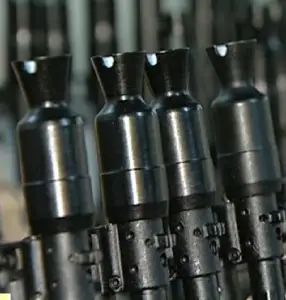One of the earliest stories this blog covered was the Russian Ministry of Defense’s cancellation of further AK purchases. They made a bunch of noises about the obsolescence of the old anvil; we thought at the time that it was posturing for budgetary reasons (bet that never happened in Uncle Joe’s day, when the AK was new). The factory that makes the AK-74, Izmash, didn’t take this lying down, and according to Russia Today has introduced a new version. The AK-12 (for 2012; the AK-74 was adopted in 1974 and its forerunner in 1947) seems to borrow from Western practice: it has a burst mode, and what appear to be Picatinny rails for optics, although they may be a Russian variation of the same concept. The stock both slides (for adjustment) and folds (for compactness). The bolt carrier looks different, with its charging handle about 30mm further forward; it’s unknown whether this means the gas system has changed.
They promise greater accuracy and modularity:
The new weapon is as reliable as the AK-74, the Izmash factory CEO Maksim Kuzyuk says (We believe he’s the guy standing behind the rifle in the photo above – Eds.), but the dynamic characteristics differ significantly. It considerably increases the accuracy of shooting. The rifle is capable of firing in three modes: single shot, three shots and automatic fire mode.
Also, AK-12 is capable of using magazines of various types and capacity.
The basic feature of the new rifle is its modularity. It will serve as a basic platform for designing of over 20 modifications of small-arms weapons of various purpose and calibre.
via Kalashnikov 5: Brand-new AK-12 rifle unveiled (VIDEO, PHOTOS) — RT.
As far as the promise of more accuracy is concerned, one thing that will help is the AK-12’s longer sighting radius. Its foresight remains mounted on a front sight tower behind the muzzle device, but its rearsight is moved to the rear of the receiver cover, in Valmet/Galil style. The rearsight remains a an open sight with a ballistic ramp for range adjustment, conceptually unchanged since Mosin-Nagant days.
Returning to the muzzle device, there are at least two types: a bulbous compensator reminiscent of a cross between the AKSU comp and the XM177 moderator, and a slender AK-74-like muzzle brake that’s has two open ports on the sides.
Another boost in aimed fire comes from the Russians’ late-but-not-never adoption of semiautomatic as the first click off safe. The rotating, ambidextrous thumb safety goes from safe (with the thumb safety to the rear) to 1 to 3 (for three-round burst capacity) to “AB” which is Cyrilic for “avtomatickiy” or automatic. Cyclic rate appears very high.
The rails, which can be used for optics, a grenade launcher, or other accessories, are found on the receiver cover, the cover over the gas tube, and both sides and bottom of the forend. Plastic covers cover the forend rails when not in use. It’s impossible to tell from the photos released to date whether the receiver cover lifts off, or is hinged like in an AKSU (Krinkov).
No word on caliber, and multiple calibers are promised for the future, but the core design is probably Russia’s standard 5.45mm. One magazine shown with the new rifle is thick and suggests a four-stack deaign, like the Suomi 50-round box (a magazine well known to Russian designers) or the new Surefire 60- and 100-round AR magazines. Magazine release is ambidextrous paddle-and-pushbutton.
The Russia Today story has more detail, more photos, and a brief video (including factory production video, and some range shooting, including a brief shot of a US M16A1) which can be streamed or downloaded.

Kevin was a former Special Forces weapons man (MOS 18B, before the 18 series, 11B with Skill Qualification Indicator of S). His focus was on weapons: their history, effects and employment. He started WeaponsMan.com in 2011 and operated it until he passed away in 2017. His work is being preserved here at the request of his family.



